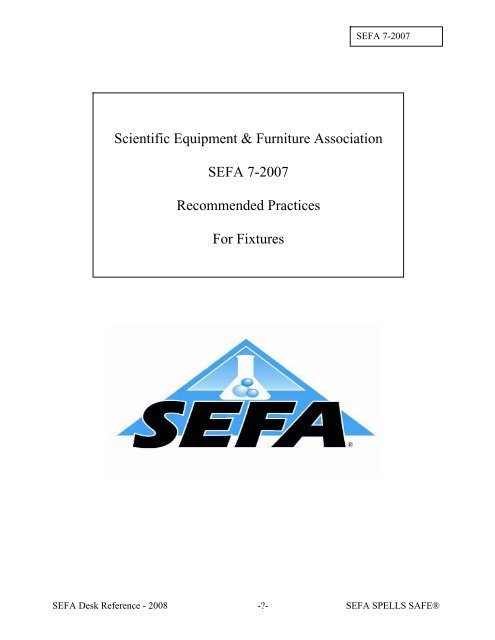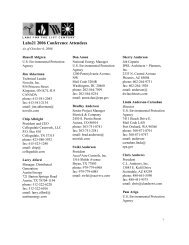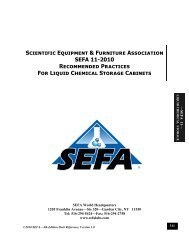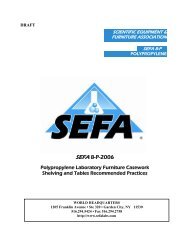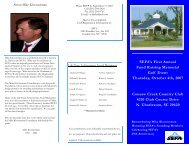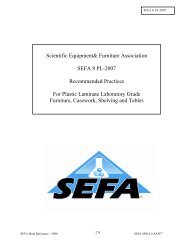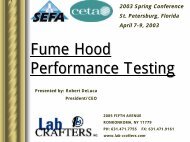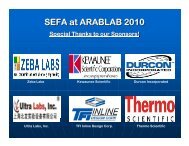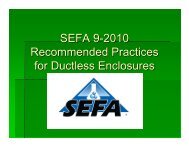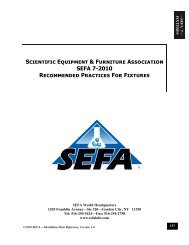Scientific Equipment & Furniture Association SEFA 7-2007 ...
Scientific Equipment & Furniture Association SEFA 7-2007 ...
Scientific Equipment & Furniture Association SEFA 7-2007 ...
- No tags were found...
Create successful ePaper yourself
Turn your PDF publications into a flip-book with our unique Google optimized e-Paper software.
<strong>SEFA</strong> 7-<strong>2007</strong><strong>Scientific</strong> <strong>Equipment</strong> & <strong>Furniture</strong> <strong>Association</strong><strong>SEFA</strong> 7-<strong>2007</strong>Recommended PracticesFor Fixtures®<strong>SEFA</strong> Desk Reference - 2008 -?- <strong>SEFA</strong> SPELLS SAFE®
<strong>SEFA</strong> 7-<strong>2007</strong>This document was written with input from the following individuals:Steve Kersten, Chairman ………………………Michael Strughn …………………………………..Stan Tracz …………………………………………Water Saver Faucet Co.Water Saver Faucet Co.<strong>Scientific</strong> PlasticsJeff McCoy………………………………………… Broen LabLarry Himmelblau …………………………………… Chicago Faucet Co.Richard Mohr ……………………………………….. Flad & Associates<strong>SEFA</strong> Desk Reference - 20082<strong>SEFA</strong> SPELLS SAFE®
<strong>SEFA</strong> 7-<strong>2007</strong>TABLE OF CONTENTSForeword……………………….Sections1.0 Scope ………………….2.0 Purpose ………………3.0 References ……………4.0 Definitions…………….5.0 Materials and Finishes…5.1 Materials Used inLaboratory Fittings..5.2 Finishes for LaboratoryService Fixtures andSafety <strong>Equipment</strong>………5.2.1 Finish Types……………5.2.2 Chrome Plated Finishes.5.2.2.1 Description of ChromePlated Finishes5.2.2.2 Performance Tests forChrome Plated Finishes.5.2.3 Corrosion Resistant Finishes5.2.3.1 Description of CorrosionResistant Finishes……….5.2.3.2 Performance Tests forCorrosion Resistant Finishes.6.0 Color Coding………………………….7.0 General Requirements forLaboratory Service Fittings………….7.1 Workmanship7.2 Handling7.3 Installation7.3.1 Fitting Design<strong>SEFA</strong> Desk Reference - 200837.3.2 Field Installation7.4 Threads and other Connections7.4.1 Pipe Threads7.4.2 Inlets for Sink Fittings…..7.4.3 Solder Connections………7.5 Marking7.5.1 Product Marking7.5.2 Packaging8.0 Water Faucets and Fittings…………8.1 General Requirements8.1.1 Working Pressures8.1.2 Working Temperatures8.2 Valve Construction8.3 Goosenecks, Spouts and OutletFittings8.3.1 General Construction8.3.2 Packings8.3.3 Outlets8.4 Testing8.4.1 Strength Tests8.4.1.1 Burst Strength Test………...8.4.1.2 Bending Loads on Fittings….8.4.1.3 Spout Strength Test…………8.4.2 Handle Security Test……….8.4.3 Valve Operating Test………8.4.4 Life Tests8.4.4.1 Life Tests for Valves………8.4.4.2 Life Test for Goosenecksand Spouts…………………8.4.5 High Temperature Extreme Test..8.4.6 Intermittent Shock Test…………<strong>SEFA</strong> SPELLS SAFE®
<strong>SEFA</strong> 7-<strong>2007</strong>9.0 Fittings for Natural Gas, Air, 11.0 Faucets Vacuum, for Purified Water…………..Special Gases and Steam11.1 Services…….. General………………………9.1 Valve Types, Applications, 11.2 etc. Fitting Materials and Construction..9.1.1 Ground Key Cock Valves………9.1.2 Laboratory Ball Valves12.0 Backflow Prevention………………9.1.3 Needle 12.1 Valves………………….General9.1.4 Steam Valves…………………..9.2 Valves for Burning 13.0 Fittings Gases…….. for ADA Compliance………9.2.1 Valve9.2.2 Certification………………….. 14.0 Vandal-Resistant Fittings………………..9.3 Mounting Fittings……………. 14.1 Resistance to Physical Abuse……9.4 Valves and Pressure 14.2 Regulators Protection of Supply Lines………for High Purity Gases………… 14.3 Maintenance…………………….9.4.1 General…………………9.4.2 Valves and PressureRegulators for 5.0 Gasses…..15.0 Electrical Fittings………………………..9.4.3 Valves and PressureRegulators for 6.0 Gasses…..10.0 Valves and Outlets for Use inFume Hoods…………………………10.1 Valve Types………………..10.1.1 Rod-Type Valves………….10.1.2 Panel Mounted Valves…….10.2 Valve Construction……….10.3 Outlet Fittings…………….10.3.1 General Construction………10.3.2 Corrosion Resistance………10.3.3 Color Coding………………10.4 Vacuum Breakers for Useon Fume Hoods……………10.5 Installation…………………16.0 Emergency Eye Wash and Shower<strong>Equipment</strong>……………………………16.1 General Requirements………….16.2 Materials and Finishes…………Appendix…………………………………………<strong>SEFA</strong> Desk Reference - 20084<strong>SEFA</strong> SPELLS SAFE®
<strong>SEFA</strong> 7-<strong>2007</strong>Forward<strong>SEFA</strong> ProfileThe <strong>Scientific</strong> <strong>Equipment</strong> and <strong>Furniture</strong><strong>Association</strong> (<strong>SEFA</strong>) is a voluntaryinternational trade association representingmembers of the laboratory furniture,casework, fume hood and related equipmentindustry. The <strong>Association</strong> was founded topromote the industry with improved quality,safety and timely completion of laboratoryfacilities in accordance with customerrequirements.<strong>SEFA</strong> Recommended Practices<strong>SEFA</strong> and its committees are active in thedevelopment and promotion ofRecommended Practices having domestic andinternational applications. RecommendedPractices are developed by the <strong>Association</strong>taking into account the work of other standardwriting organizations. Liaison is alsomaintained with other associations andgovernmental agencies in the development oftheir specifications.<strong>SEFA</strong>’s Recommended Practices aredeveloped in and for the public interest.These practices are designed to promotebetter understanding between manufacturersand purchasers and to assist the purchaser inselecting and specifying the proper product tomeet the user’s particular needs. Theexistence of a <strong>SEFA</strong> Recommended Practicedoes not preclude any member or nonmemberfrom providing products or servicesthat do not conform to these RecommendedPractices. <strong>SEFA</strong> welcomes any proposedchanges or additions to these RecommendedPractices and encourages all interested partiesto participate in this important endeavor.<strong>SEFA</strong>’s Recommended Practices are notcopyrighted and may be disseminated withoutwritten permission for their widest possibleuse by quoting or photocopying whenevernecessary.<strong>SEFA</strong> uses its best effort to promulgateRecommended Practices for the benefit of thepublic in light of available information andaccepted industry practices. <strong>SEFA</strong> does notguarantee, certify, or assure the safety orperformance of any products, components, orsystems tested, installed, or operated inaccordance with <strong>SEFA</strong> RecommendedPractices or that any tests conducted under itsRecommended Practices will be nonhazardousor free from risk.<strong>SEFA</strong> Desk Reference - 20085<strong>SEFA</strong> SPELLS SAFE®
<strong>SEFA</strong> 7-<strong>2007</strong>1.0 ScopeThis Recommended Practice applies to (i)laboratory service fittings and fixtures,including faucets, valves and relatedproducts, and (ii) safety equipment, consistingof emergency eye washes, emergencyshowers and related products.2.0 Purpose<strong>SEFA</strong> has developed and made available thisRecommended Practice as a guide forregulatory agencies, architects, engineers,consultants, specification writers, contractors,manufacturers and dealers of laboratoryfurniture, installers, facilities managers andusers who specify, recommend for purchase,install and/or use laboratory service fittingsand safety equipment. It is intended toprovide the laboratory community with themost suitable products for dependableperformance and safe sanitary installations.Specific construction features of the productscovered by this Recommended Practice havenot been considered.3.0 References“Plumbing Fixture Fittings”, ASMEA112.18.1-2005“Standard Specification for Copper Alloysin Ingot Form”, ASTM B30-04“Standard Specification for Copper andCopper Alloy Forging Rod, Bar, and Shapes”,ASTM B124 / B124M-04“Standard Specification for Seamless BrassTube”, ASTM B135-02“Standard Specification for Seamless RedBrass Pipe, Standard Sizes”, ASTM B43-98(2004)“Standard Specification for Free-CuttingBrass Rod, Bar and Shapes for Use in ScrewMachines”, ASTM B16 / B16M-05“Standard Specification for Seamless CopperWater Tube”, ASTM B88-03“Standard Specification for Aluminum andAluminum-Alloy Bar, Rod, and Wire”,ASTM B211-03“Standard Specification for Aluminum-AlloySand Castings”, ASTM B26 / B26M-03“Standard Specification for ElectrodepositedCoatings of Copper Plus Nickel PlusChromium and Nickel Plus Chromium”,ASTM B456-03“Standard Specification for QualitativeAdhesion Testing of Metallic Coatings”,ASTM B571-97 (2003)“Standard Test Method for ChippingResistance of Coatings”, ASTM D3170-03“Standard Test Method for Mandrel BendTest of Attached Organic Coatings”, ASTMD522-93a (2001)“Standard Test Methods for MeasuringAdhesion by Tape Test”, ASTM D3359-02“Standard Test Method for Effect ofHousehold Chemicals on Clear andPigmented Organic Finishes”, ASTM D1308-02<strong>SEFA</strong> Desk Reference - 20086<strong>SEFA</strong> SPELLS SAFE®
<strong>SEFA</strong> 7-<strong>2007</strong>water, entering through an outlet of the supplyfitting, will flow back to the supply lines bygravity and/or any pressure belowatmospheric in the supply line when the watercontrol valve is wide or fully open.Deck Mounted Fitting A fitting that mountson a horizontal surface.Diaphragm or Bellows Valve A type ofvalve that utilizes a diaphragm or bellows toseparate the operating components of thevalve (such as the valve stem and bonnet)from the areas through which the gas flowsthrough the valve. The purpose of this type ofvalve is to prevent permeation of atmosphericimpurities into the gas flowing through thevalve. These valves are sometimes alsoreferred to as “packless” valves.Effective Waterway (Opening) Theminimum cross-sectional area at the point ofwater supply discharge, measured orexpressed in terms of (i) the diameter of acircle, or (ii) if the opening is not circular, thediameter of a circle of equivalent crosssectionarea.Fitting A device designed to control and/orguide the flow of water, gases, vacuum orsteam. Also referred to as a “service fitting”.Faucet A device designed to control and/orguide the flow of water. A faucet generallyincorporates some type of gooseneck or spout.Fixture In the plumbing industry, a fixturerefers to a sink or receptacle that receiveswater or water-borne wastes and dischargesinto a drainage system. However, in thelaboratory field, the term “fixture” has beenused to describe a fitting or service fitting.Also referred to as a “laboratory fixture”,“service fixture” or “laboratory servicefixture.”Flange A type of mounting fitting generallyused to hold a valve perpendicular to a wall or<strong>SEFA</strong> Desk Reference - 20088other vertical surface. May also be referred toas a “panel flange.”Flood Level Rim The top edge of a receptorover which water would overflow.Foot Operated Valve A valve for waterservice that is operated by the user’s foot.The valve may be either single or mixing andmay be mounted on the floor, a ledge or awall. Also referred to as a “pedal valve.”Front Loaded Remote Control Valve Avalve for use on a fume hood that is installedon the front face or post of the fume hood.The valve is usually designed so that theworking components of the valve areaccessible from the front exterior face of thehood. Also referred to as a “panel mountedremote control valve.”Fuel Gas A gas that can be burned to supplyheat. In laboratory applications, fuel gasgenerally refers to natural gas.Gas In laboratory applications, may refer toeither fuel gas or to other substances in agaseous state, such as nitrogen, helium, argonand oxygen. These latter gases may also bereferred to as “special gases” or “cylindergases.”Gas Purity The purity of a gas is a functionof the quantity of impurities present in asample of the gas. A gas that is 99.999% purehas .001% impurities in it. A gas that is99.998% pure has .002% impurities in it.Gas purity may also be designated by a twodigit code. The first digit of the coderepresents the “number of nines” in thepercentage value designating the purity of thegas and the second digit indicates the lastdecimal digit, if it is smaller than “nine”. Forexample, a gas that is 99.999% pure isreferred to as being a “5.0” gas. A gas that is99.998% pure is referred to as being a “4.8”gas.<strong>SEFA</strong> SPELLS SAFE®
<strong>SEFA</strong> 7-<strong>2007</strong>Ground Key Cock A type of valve used forcontrolling low pressure gases. The valveoperates by means of a tapered cylindricalplug that fits into a matching tapered bore inthe valve body. The tapered plug is groundand lapped and held in the valve body undercontinuous pressure to form a gastight seal inthe valve body. Rotation of the tapered plug90 degrees opens and closes the valve.Gooseneck A component of a faucet, usuallyfabricated of pipe or tubing and usually in theshape of the letter U, whose function is todirect the flow of water into a sink orreceptor. Goosenecks may be of the rigid,swing or convertible rigid/swing type andmay incorporate a vacuum breaker.High Purity Gases Any gas that has a levelof purity or chemical composition that iscertified as high purity by the gasmanufacturer. For purposes of thisRecommended Practice, high purity gases aregases with a certified purity level of 5.0 orgreater (see definition of “gas purity” above).Index Button An indicator fitted into the topsurface of the handle of a fitting that serves toidentify the media or service being suppliedby the fitting. For standards for color codingand symbols of services, refer to Section 6.Manifold A pipe or tube on which multiplefittings or outlets are mounted in parallel,relatively close together. On a typicalmanifold, one end is connected to a supplyand the other end is plugged.Manual Control A type of valve mechanismwherein, once the valve is opened, the valveremains open until it is manually closed. Alsoreferred to as “compression control.”May When used, indicates an alternaterequirement or option.Mixing Valve, Faucet or Fitting A valve orfaucet designed to mix hot and cold water by<strong>SEFA</strong> Desk Reference - 20089means of automatic or manual regulation.Mixing Valve, Single Control A fitting witha single handle or control that shall serve toturn water on and off, and to change volumeand temperature by means of a single handle.Monel An alloy of approximately 67%nickel, 28% copper and 5% other elementsthat is made by direct reduction from ore inwhich the constituent metals occur in theseproportions.Mounting Fitting A fitting used to install ormount a valve on a horizontal or verticalsurface. Examples of mounting fittingsinclude turret bases, panel flanges and wyefittings.Mounting Shank A threaded length of pipeused for securing a fitting to a horizontal orvertical surface and to supply water, gas orother media to the fitting. The pipe should bemachined with a taper pipe thread to connectto the fitting, a straight pipe thread for alocknut and either a straight or taper pipethread to connect to the supply line. Themounting shank should be supplied by themanufacturer with a locknut and lockwasher.Also referred to as a “supply nipple” or “tanknipple.”Needle Valve A type of valve in which anorifice is opened or closed by means of aneedle or cone that is moved into orwithdrawn from it.Nipple A short piece of pipe that is threadedat both ends.Outlet Fitting An accessory that is installedin the outlet end of a fitting.Pedestal See Turret Base.Polyethylene (PE) A plastic polymer ofethylene.Polypropylene (PP) Any of various<strong>SEFA</strong> SPELLS SAFE®
<strong>SEFA</strong> 7-<strong>2007</strong>thermoplastic plastics that are polymers ofpropylene.Polyvinyl Chloride (PVC) A waterinsoluble, thermoplastic material derived bythe polymerization of vinyl chloride.Polyvinylidene Flouride (PVDF) Afluoropolymer that is chemically resistant tomost acids, bases and organic solvents.Potable Water Water that is satisfactory fordrinking, culinary, and domestic purposes,and meets the requirements of the healthauthority having jurisdiction.Pressure Gauge An instrument thatmeasures and indicates the pressure of aliquid or gas.Pressure Regulator A device that regulatesthe pressure of a liquid or gas that is deliveredthrough it.Push/Turn Valve A type of valve that has ahandle that locks in the closed position andmust be pushed down to permit the handle torotate to open the valve. The internalconstruction of the valve shall incorporaterotating ceramic discs or other type of valvemechanism suitable for the intended use.Push/turn valves are generally used fornatural and other burning gases.Quick Connect A fitting consisting of abody and a plug that interlock together toform a watertight or gastight connection. Thebody and plug may each have an internalvalve to shut off the supply line when the twocomponents are disconnected. The body andplug may also be keyed to form a matchedset. Also referred to as a “quick disconnect.”Remote Control Valve A type of valve foruse in a fume hood, where the handle of thevalve is located on the outside of the hood(generally on the front face or post of thehood or underneath the hood). A remote<strong>SEFA</strong> Desk Reference - 200810control valve is usually connected to an outletfitting that is installed within the interior ofthe fume hood. A remote control valve canbe either a rod-type valve or a front loadedvalve (see definitions).Renewable Unit A cartridge or unit thatcontains all of the working components of avalve and can be removed from the fittingbody and replaced without disturbing thefitting body. Also referred to as a“replaceable unit.”Rod-Type Remote Control Valve A type ofremote control valve where the valve ismounted within the side wall or underneaththe fume hood. The valve is fitted with anextension rod that projects from the valvethrough the face of the hood or through theapron underneath the hood and a handle ismounted on the end of the rod.Seat The surface around or within an orificein a faucet or valve through which water orgas flows and against which a closingmember, such as a disc or washer, is pressedor seated to terminate the flow. Also referredto as a “valve seat.” A “renewable seat” is aseat that is separate from the valve body andcan be removed and replaced, either with orwithout a tool.Seat Disc A disc or washer that, whencompressed against a seat, provides awatertight or gastight seal. Also referred to asa “valve disc” or “bib washer”.Self-Closing Control A type of valvemechanism that closes automatically when thehandle is released.Serrated Hose End An outlet fitting that hasgraduated serrations that will accommodatehose or tubing. Also referred to as a “serratednozzle” or “serrated tip.”Service The supplying of utilities such aswater, air, gas, vacuum and steam as required<strong>SEFA</strong> SPELLS SAFE®
<strong>SEFA</strong> 7-<strong>2007</strong>in a laboratory. “Service” or “media” alsorefers to the specific liquid or gas that isdelivered by a particular fitting.Service Fitting Any device that controlsand/or guides the flow of a service in alaboratory.Shall Where used, indicates a mandatoryrequirement.Single Valve, Faucet or Fitting When usedwith reference to a water fitting, a fitting thatdelivers either cold, hot or tempered wateronly, without the capability of mixing thewater.Significant Surface An exposed surface that,if marred, would detract from the appearanceof the fitting.Standard Tools Tools, such as ascrewdriver, key wrench, flat jawed wrench,strap wrench and pliers, which are normallycarried by plumbers for the installation andmaintenance of plumbing.Valve A device or fitting by which flow maybe started, stopped or regulated by a movablepart that opens or obstructs one or morepassages.Water The liquid that descends from theclouds as rain, forms streams, lakes and seas,and is a major constituent of all living matterand that is an odorless, tasteless, very slightlycompressible liquid oxide of hydrogen whichappears bluish in thick layers, freezes at 0 Cand boils at 100 C, has a maximum density at4 C and a high specific heat, is feebly ionizedto hydrogen and hydroxyl ions, and is a poorconductor of electricity and a good solvent.Wrist Blade Handle A handle that permitsthe control of a faucet with the wrist orforearm.Wye Fitting A type of mounting fitting thatis similar to a panel flange except with twooutlets.Straight Pattern Valve A valve that has itsinlet port and outlet port at 180° to each other,with the operating stem at 90° to the inletport.Turret or Turret Base A type of mountingfitting, usually cylindrical in shape, used toinstall one or more fittings on a horizontal orvertical surface. The fittings are held parallelto the surface on which the turret base isinstalled.Vacuum Breaker A device to prevent thecreation or formation of a vacuum in a pipingsystem by admitting air at atmosphericpressure. A vacuum breaker is used toprevent back siphonage. A vacuum breakerused on a laboratory faucet may be either anatmospheric vacuum breaker (as definedabove) or a laboratory faucet vacuum breakerhaving two independent acting check valves.<strong>SEFA</strong> Desk Reference - 200811<strong>SEFA</strong> SPELLS SAFE®
<strong>SEFA</strong> 7-<strong>2007</strong>5.0 Materials and Finishes5.1 Materials Used in LaboratoryFittingsAll materials used in laboratory servicefittings shall be of the highest quality, shall besuitable for the intended use and shall meet orexceed the applicable standards listed below:Brass Castings. Red brass castings shall bemade of commercial red brass alloyconforming to ASTM Specification B30-04,C/Metal alloy, having a nominal compositionof 81% copper.Brass Forgings. Brass forgings shallconform to ASTM Specification B124-74,Alloy No. 377, having a nominal compositionof 59% copper.Seamless Brass Tube. Seamless brass tubingshall conform to ASTM Specification B135-74, Alloy No. 280, having a nominalcomposition of 60% copper.Seamless Red Brass Pipe. Seamless redbrass pipe in standard sizes shall conform toASTM Specification B43-74, having anominal composition of 84 to 86% copper.Free-Cutting Brass Rod, Bar & Shapes forUse in Screw Machines. Componentsfabricated of free-cutting brass rod, bar andshapes for use in screw machines shallconform to ASTM Specification B16-74,having a nominal composition of 60 to 63%copper.Aluminum Castings. Aluminum castingsshall conform to ASTM Specification B26-74, Alloy No. SG70A, having a chemicalcomposition of 0.25% maximum copper,0.6% maximum iron, 6.5% to 7.5% rangesilicon, 0.35% maximum manganese, 0.20%to 0.40% range magnesium, 0.35% maximumzinc, 0.25% maximum titanium, 0.15%<strong>SEFA</strong> Desk Reference - 200812maximum total other, and balance aluminum.Aluminum Rod, Bar, Tube and Shapes.All components fabricated of aluminum rod,bar, tube, and shapes shall conform to ASTMSpecification B211-74, Alloy No. 6061-T6,having a nominal composition of 1.0%magnesium, 0.6% silicon, 0.25% chromium,0.25% copper, and balance aluminum.Polypropylene. All components fabricatedof polypropylene shall be non-pigmented andconform to ASTM Specification D4104.5.2 Finishes for Laboratory ServiceFixtures and Safety <strong>Equipment</strong>5.2.1 Finish TypesThe finish on laboratory service fittings andsafety equipment shall be categorized aseither a (i) chrome plated finish, or (ii) acorrosion resistant coated finish. Other typesof finishes are not recommended for use in alaboratory environment.5.2.2 Chrome Plated Finishes5.2.2.1 Description of Chrome PlatedFinishesChrome plated finishes shall consist of either(i) a layer of chromium applied over a layer ofnickel applied over a layer of copper that isapplied over all exposed surfaces of thecomponents of the fitting itself, or (ii) a layerof chromium applied over a layer of nickelthat is applied over all exposed surfaces of thecomponents of the fitting itself. Chromeplated finishes shall be applied inconformance with “Standard Specificationsfor Electrodeposited Coatings of Copper PlusNickel Plus Chromium and Nickel PlusChromium”, ASTM B456-03. Finishes shallmeet the requirements for Service ConditionNo. SC 4 (Very Severe Service) for nickel<strong>SEFA</strong> SPELLS SAFE®
<strong>SEFA</strong> 7-<strong>2007</strong>plus chromium coatings on copper or copperalloys.5.2.2.2 Performance Tests for ChromePlated FinishesChrome plated finishes shall meet therequirements for adhesion as specified in“Standard Practice for Qualitative AdhesionTesting of Metallic Coatings”, ASTM B571-97. The applicable tests shall be the (i)burnishing test, (ii) chisel-knife test, (iii) filetest, and (iv) peel test.5.2.3 Corrosion Resistant Finishes5.2.3.1 Description of CorrosionResistant FinishesCorrosion resistant finishes shall be anorganic coated finish applied to all exposedsurfaces of the fitting. The finish may beeither colored or clear. Coating material shallbe either epoxy, epoxy/polyester hybrid, orpolyester. Corrosion resistant finish can beapplied as either a wet finish or a dry, powdercoated finish. In either case, followingapplication of the coating material, the fittingshall be baked to cure the coating material. .5.2.3.2 Performance Tests forCorrosion Resistant FinishesCorrosion resistant finishes shall meet thefollowing tests:a. Fume Test.Prepare samples of fittings having thecorrosion resistant finish to be tested.Suspend samples in a container at least 6cubic feet capacity, approximately 12" aboveopen beakers, each containing 100 cc of 70%nitric acid, 94% sulfuric acid and 35%hydrochloric acid, respectively. Afterexposure to the fumes from these reagents for150 hours, the finish shall show nodiscoloration, disintegration or other effects.b. Direct Application TestPrepare samples of flat brass panels with thecorrosion resistant finish to be tested. Thetest shall consist of direct application of thereagents listed below. For nonvolatilechemicals, chemical spot tests shall be madeby applying five (5) drops of each reagent tothe surface to be tested and covering with a 11/4" diameter watch glass (concave sidedown) to confine the reagent. For volatilechemicals, chemical spot tests shall be madeby placing a cotton ball saturated with thereagent on the surface to be tested andcovering with an inverted two-ounce widemouth bottle to retard evaporation. All spottests shall be conducted in such a manner thatthe test surface is kept wet throughout theentire test period and at a temperature of 77°F ±3° F. For both methods, leave the reagentson the panel for a period of one hour. At theend of the test period, (i) the reagents shall beflushed from the surface with water, (ii) thesurface shall be scrubbed with a soft bristlebrush under running water, and (iii) thesurface shall be rinsed and dried.Immediately prior to evaluation, 16 to 24hours after the reagents are removed, the testsurface shall be scrubbed with a damp towelanddried.<strong>SEFA</strong> Desk Reference - 200813<strong>SEFA</strong> SPELLS SAFE®
<strong>SEFA</strong> 7-<strong>2007</strong>Test ReagentsTest No. Chemical Reagent Test Method1. Acetate, Amyl Cotton ball & bottle2. Acetate, Ethyl Cotton ball & bottle3. Acetic Acid, 98% Watch glass4. Acetone Cotton ball & bottle5. Acid Dichromate, 5% Watch glass6. Alcohol, Butyl Cotton ball & bottle7. Alcohol, Ethyl Cotton ball & bottle8. Alcohol, Methyl Cotton ball & bottle9. Ammonium Hydroxide, 28% Watch glass10. Chloroform Cotton ball & bottle11. Cresol Cotton ball & bottle12. Dichlor Acetic Acid Cotton ball & bottle13. Dimethylformanide Cotton ball & bottle14. Ethyl Ether Cotton ball & bottle15. Formaldehyde, 37% Cotton ball & bottle16. Formic Acid, 90% Watch glass17. Furfural Cotton ball & bottle18. Gasoline Cotton ball & bottle19. Hydrochloric Acid, 37% Watch glass20. Hydrofluoric Acid, 48% Watch glass21. Hydrogen Peroxide, 3% Watch glass22. Iodine, Tincture of Watch glass23. Methyl Ethyl Ketone Cotton ball & bottle24. Methylene Cloride Cotton ball & bottle25. Mono Chlorobenzene Cotton ball & bottle27. Nitric Acid, 20% Watch glass28. Nitric Acid, 30% Watch glass29. Nitric Acid, 70% Watch glass30. Phenol, 90% Cotton ball & bottle31. Phosphoric Acid, 85% Watch glass32. Silver Nitrate, Saturated Watch glass33. Sodium Hydroxide, 10% Watch glass34. Sodium Hydroxide, 20% Watch glass35. Sodium Hydroxide, 40% Watch glass36. Sodium Hydroxide, Flake Watch glass37. Sodium Sulfide, Saturated Watch glass38. Sulfuric Acid, 33% Watch glass39. Sulfuric Acid, 77% Watch glass40. Sulfuric Acid, 96% Watch glass41. Sulfuric Acid, 77% andNitric Acid, 70%, equal partsWatch glass42. Trichloroethylene Cotton ball & bottle43. Xylene Cotton ball & bottle44. Zinc Chloride, Saturated Watch glassNote: Where concentrations are indicated, percentages are by weight<strong>SEFA</strong> Desk Reference - 200814<strong>SEFA</strong> SPELLS SAFE®
<strong>SEFA</strong> 7-<strong>2007</strong>Test Evaluation: Evaluation of test resultsshall be based on the following rating system:Level 0 – No detectable change.Level 1 – Slight change in color or gloss.Level 2 – Slight surface etching or severestaining.Level 3 – Pitting, cratering, swelling, orerosion of coating. Obvious andsignificant deterioration.Acceptance Level: Results will vary frommanufacturer to manufacturer. Corrosionresistant finishes should result in no morethan four Level 3 conditions. Suitability for agiven application is dependent upon thechemicals used in a given laboratory.c. Adhesion TestCorrosion resistant finishes shall meet thestandards set forth in “Standard Test Methodsfor Measuring Adhesion by Tape Test”,ASTM D3359-02, “Standard Test Method forMandrel Bend Test of Attached OrganicCoatings”, ASTM D522-93a and “StandardTest Method for Chipping Resistance ofCoatings”, ASTM D3170-03.6.0 Color CodingThe handle of each laboratory fitting (exceptpressure regulators) shall be marked toindicate the particular liquid or gas that isdelivered by or through such fitting. Thehandle or the index button fastened to thehandle shall be color coded, and the indexbutton shall be marked with a symbol todesignate the service. Letters used todesignate the service or symbol shall belegible and easy to read. Symbols shall be inaccordance with the list below:Service Color SymbolWater:Cold Water Dark Green CWHot Water Red HWPurified Water:Deionized Water White DIDistilled Water White DWReverse Osmosis White ROWaterAir:Air Orange AIRCompressed Air Orange CANatural Gas:Gas Dark Blue GASNatural Gas Dark Blue NATGASOther Gases:Acetylene Violet C2H2Argon Violet ARCarbon Dioxide Pink CO2Helium Black HEHydrogen Pink H or H2Nitrogen Gray N or N2or NITNitrogen Brown N or N2or NITOxygen Light Green OXY orO2Special Gas Light Blue SGAll Other Gases Light BlueChemical SymbolVacuum:Vacuum Yellow VACSteam:Steam Black STM orS<strong>SEFA</strong> Desk Reference - 2008157.0 General Requirements forLaboratory Service Fittings<strong>SEFA</strong> SPELLS SAFE®
<strong>SEFA</strong> 7-<strong>2007</strong>7.1 WorkmanshipLaboratory service fixtures shall be ofsuperior workmanship. Working parts shall beuniform and shall have smooth, evenmachining free of burrs, rough edges andragged threads.7.2 HandlingFittings and components shall withstandnormal handling and installation withoutdamage or distortion of any part. Wherespecial handling of a fitting is required,appropriate instructions shall either beattached to the fitting or packaged therewith.7.3 Installation7.3.1 Fitting DesignFittings shall be designed to readily facilitatefield installation, as follows:a. All fittings shall be provided withsuitable means to connect to a type of supplyline in common use in laboratories.b. The fitting manufacturer shall design itsfittings or shall otherwise provide that fittingsmay be installed and connected withoutmarring the finish or otherwise damaging thefitting or the surface on which it is to bemounted.c. Deck mounted fittings shall befurnished with mounting shanks withsufficient length to be mounted on countertops up to 1 1/2 inches thick. The diameter ofthe base of the fitting, flange or cover plateshall not be less than 1 1/2 inches.d. Panel mounted combination hot and coldwater faucets shall be furnished with uniontype inlets for ease of installation. Thediameter of the flange or cover plate shall notbe less than 1 1/2 inches.<strong>SEFA</strong> Desk Reference - 200816e. Means shall be provided to securelymount the fitting to withstand loadingnormally encountered in service.7.3.2 Field InstallationThe installer responsible for the installation oflaboratory service fittings shall follow goodplumbing practice. Installers shall, inparticular:a. Thoroughly clean and flush supply linesprior to installing fittings, as pipe shavings,scale and other debris can be carried througha pipe and into a faucet or valve when theplumbing system is activated. Such foreignmatter can damage valve components andinterfere with the proper operation of thefitting.b. Secure the fitting to a counter top or wallusing the locknut and lock washer providedby the manufacturer. Tighten the locknutsufficiently to secure the fitting to the counteror wall, but care shall be taken not to overtighten.c. Observe the manufacturer’s recommendedtest and working pressures for fittings.Testing or using a fitting at pressure for whichit is not designed can result in leakage orfailure.d. Clean fittings using a soft cloth and soapywater. Use of abrasives, detergents or othercleaners can damage the finish on a fitting.Solvents shall not be used in or near a fitting,as solvents can dissolve lubricants used in thevalve mechanism of a fitting.7.4 Threads and Other Connections7.4.1 Pipe Threadsa. Taper pipe threads on inlets and fieldassembled joints shall conform to ASMEB1.20.1.<strong>SEFA</strong> SPELLS SAFE®
<strong>SEFA</strong> 7-<strong>2007</strong>b. Threaded connections having IPS threadsshall be tested with a torque wrench to applytorque load specified below without showingevidence of cracking or separation. Distortionor failure of any component part of theassembly shall constitute a failure of theassembly. Torque measurements shall bemade with torque wrenches having amaximum allowable inaccuracy of 3% of thefull scale reading.Thread Assembling Torques:Fitting Size (IPS) Torque, Ft-Lb (N-m)3/8 32 (43)½ 45 (61)¾ 65 (88)1 95 (129)7.4.2 Inlets for Sink FittingsShank lengths of deck mounted fittings shallbe at least 1 ¾ inches (45 mm).7.4.3 Solder ConnectionsThe dimensions of solder joint end forconnection to copper tube or copper tubefittings, except factory assembled parts, shallconform with respect to length and diameterof the joint section to the dimensions given inASME B16.18 or ASME B16.22.7.5 Marking7.5.1 Product Markinga. Each fitting shall bear permanent legiblemarkings to identify the manufacturer. Thismarking shall be the trade name, trademark,or other mark known to identify themanufacturer or in the case of privatelabeling, the name of the customer ortrademark for whom the fitting wasmanufactured. Such marking shall be locatedwhere it can be seen after installation. Thismarking shall be by means of either a<strong>SEFA</strong> Desk Reference - 200817permanent mark or a permanent label on theproduct.b. Permanent labels shall comply with theperformance requirements of UL 969. Labelsshall comply with the requirements for indooruse where exposed to high humidity oroccasional exposure to water, and shall have atemperature rating of at least 176 F (80 C).7.5.2 PackagingThe package shall be marked with themanufacturer’s name and model number, or inthe case of private labeling, the name of thecustomer or trademark for whom the fittingwas manufactured.8.0 Water Faucets and Fittings8.1 General Requirements8.1.1 Working PressuresAll faucets and fittings for water service shallbe designed to function at water workinggauge pressures between 20 PSI (140 kPa)and 125 PSI (860 kPa), and for intermittentshock gauge pressures up to 180 PSI (1,240kPa).8.1.2 Working TemperaturesAll faucets and fittings for water service shallbe designed to function at supplytemperatures from 40 F (4C) to 150 F (66 C)and shall withstand 180 F (82 C) for 0.5 hourswithout failure of the pressure envelope.8.2 Valve Constructiona. All faucets and fittings for water serviceshall be designed to have either (i) arenewable unit or cartridge containing allworking components subject to wear, or (ii)renewable working components, includingseat, seat disc and seals. After installation ofthe faucet or fitting, all wearing parts shall becapable of being replaced and such<strong>SEFA</strong> SPELLS SAFE®
<strong>SEFA</strong> 7-<strong>2007</strong>replacement shall be able to be accomplishedwithout removing the body from the piping ordisconnecting the fitting from the supply pipeor surface on which it is installed.b. Joints which may have to be taken apart toreplace worn parts after the fitting is installedshall be designed so that they may bedisassembled and reassembled withoutdamaging or marring a significant surface ofthe fitting or a significant surface on whichthe fitting is installed.c. The seat disc arrangement shall be madeso that it will neither vibrate nor loosen inservice and so that it can be replaced.d. Packings shall be of such design andquality as to ensure leak-proof joints and becapable of providing satisfactory field service.8.3 Goosenecks, Spouts and OutletFittings8.3.1 General ConstructionGoosenecks and spouts shall be one of thefollowing types:a. Rigid Construction. Goosenecks andspouts may be rigid (i.e. non-moveable) type.Rigid goosenecks shall thread directly into thefaucet body and shall be constructed so as tobe immobile in ordinary use. Rigidgoosenecks are typically used at cup sinklocations.b. Swing Construction. Goosenecks andspouts may be swing or swivel type. Swinggoosenecks and spouts shall be able to swivelaround the faucet body. Swing goosenecksare typically used at laboratory sinks.c. Rigid/Swing or Convertible Construction.Goosenecks and spouts may be rigid/swing orconvertible construction. Goosenecks shallbe capable of being either rigid or swing, andmay be converted in the field from rigid to<strong>SEFA</strong> Desk Reference - 200818swing and vice versa.8.3.2 Packingsa. Packings shall be of such design andquality as to ensure leak-proof joints and becapable of providing satisfactory field service.b. Swing goosenecks and spouts designed touse an adjustable packing in the joint betweenthe spout and the body shall be constructed sothat the adjustments can be made withoutremoving the gooseneck or spout.8.3.3 Outletsa. The outlet of all goosenecks and spoutsshall have a 3/8 inch NPS or NPT femalethread or be so designed as to accommodatean adapter with a 3/8 inch NPS or NPTfemale thread.b. All outlet fittings and accessories, suchas serrated hose ends, aerators and aspirators,shall have a 3/8 inch NPS or NPT male threador be so designed as to accommodate anadapter with a 3/8 inch NPS or NPT malethread.8.4 Testing8.4.1 Strength Tests8.4.1.1 Burst Strength TestFittings shall withstand a hydrostatic gaugepressure of 500 PSI (3,445 kPa) for two (2)minutes. The pressure shall be applied (i) forone (1) minute to the inlet with the valve(s)closed, and (ii) for one (1) minute to the inletwith the outlet blocked and the valve open.The fitting shall not show any permanentdistortion or failure of the pressure envelope.8.4.1.2 Bending Loads on FittingsNo cross section of a rigid waterway on thepressure side of a faucet or fitting shall bedamaged when tested in accordance with the<strong>SEFA</strong> SPELLS SAFE®
<strong>SEFA</strong> 7-<strong>2007</strong>at 140 F +/- 10 F (60 C +/- 5 C). Bothsupplies shall be at the same flowing gaugepressure of 50 +/- 5 PSI (350 +/- 35 kPa).Manually operated fittings shall be operatedfrom full off to three-eighths of a turn open,but not to exceed three-fourths of themaximum amount of turning from fullyclosed to fully open, and back to full off (onecycle) at the rate of 1,500 cycles per hour(minimum). The test apparatus shall applysufficient load to close the valve throughoutthe test, but shall in no case exceed 50%greater than the load specified in Section 8.2.3above.2. Single control mixing valves shall becycled alternately from off to full hot andback for 30 cycles, and from off to full coldand back for 30 cycles.8.4.4.2 Life Test for Goosenecks and Spoutsa. Swing goosenecks and spouts shall besubjected to a life test for 50,000 cycles ofoperation. The swing gooseneck or spoutshall (i) hold a hydrostatic gauge pressure of125 PSI (860 kPa) for 1 minute after 25,000cycles with the original seal in place; and (ii)hold a hydrostatic gauge pressure of 125 PSI(860 kPa) for 1 minute after 50,000 cycles.The seal may be replaced to pass once duringthis test.b. The test procedure for swing goosenecksand spouts shall be as follows. The fittingshall be mounted on the life test apparatuswith the axis about which the spout turns inline with the axis of the drive spindle. Theforked end of the drive adapter shall be fittedloosely over the spout; the drive adapter shallbe free to move vertically and shall be soweighed that a bending torque of 5 in.-lbf (0.6N-m) shall be applied at the base of the spout;the apparatus shall be adjusted to turn thespout through a 90 degree arc, 45 degrees toeach side of center. The turning mechanismshall be loaded to apply a static torque of 24in.-lbf (2.7 N-m) to the centerline of the base<strong>SEFA</strong> Desk Reference - 200820of the spout. Cycle speed shall be 1,500cycles per hour, and hot and cold wateralternated every 6,000 cycles. Hot and coldwater temperatures and pressures are to be asin the valve test.8.4.5 High Temperature Extreme TestFaucets and fittings designed for waterservice shall withstand a water temperature of180 F (82 C) for 1 hour without failure of thepressure envelope. The fitting shall beconnected to a hot water supply of 180 F (82C). The cold water inlet shall be blocked. Ashutoff valve shall be connected to the outletand the hot water bled through it to maintain180 F +/- 5F (82 C +/-3 C) within the fittingfor 1 hour at a gauge pressure of 125 PSI (860kPa). The fitting shall be considered to havefailed if it leaks after the test when a gaugepressure of 125 PSI (860 kPa) is applied withthe valve in a closed position.8.4.6 Intermittent Shock Testa. Faucets and fittings designed for waterservice shall withstand an intermittent shockgauge pressure to 180 PSI (1,240 kPa) from asimulated apparatus connected to the spoutoutlet as described below.b. Water supply to the hot side of the fittingshall be at 140 F +/- 10 F (60 C +/- 5 C) suchthat the flow gauge pressure is 125 PSI at 2.0+/- .24 GPM (860 kPa at 7.6 +/- .95 L/min)with the fitting in the full hot position. Thecold side inlet shall be at a gauge pressure of125 PSI (860 kPa) static and at ambient coldwater temperature. A simulated apparatussuch as rapid closing solenoid valve shall beconnected downstream of the spout so as tocreate a shock gauge pressure of 180 PSI(1,240 kPa). The solenoid valve shall becycled at a rate of two seconds open, twoseconds closed for a duration of 30,000cycles.c. Any leakage shall be cause for rejection<strong>SEFA</strong> SPELLS SAFE®
<strong>SEFA</strong> 7-<strong>2007</strong>under the following conditions: (i) at the endof the test, examine the pressure envelopewhile still at test pressure; (ii) turn off thevalve(s), disconnect the simulated appliancefrom the spout outlet, and examine withpressure still applied to the inlet.9.0 Fittings for Natural Gas, Air,Vacuum, Special Gases and SteamServices9.1 Valve Types, Applications, etc.9.1.1 Ground Key Cock Valvesa. Due to the widespread use and acceptanceof laboratory ball valves, ground key cockvalves are no longer recommended for use inscience laboratories.9.1.2 Laboratory Ball Valvesa. Laboratory ball valves may be used fornatural gas, air, vacuum and special gasservices. In addition, laboratory ball valvesmay be used for water service. Where usedfor oxygen or high purity gases, valves shallbe specially cleaned, lubricated and packed.Ball valves provide on/off control of theservice, with a limited degree of metering orcontrol of the service.b. Ball valves operate by means of aspherical “ball” that is positioned betweentwo seals that are within a body housing andpress against the ball to form a watertight orgastight seal. Rotation of the ball 90 degreesopens and closes the valve. Valves haveeither a lever-type handle or a handle thatlocks in the closed position and must be liftedto open the valve. In either case, the valvehandle shall visually indicate whether thevalve is open or closed.c. Ball valves shall be designed for aworking pressure of at least 75 PSI.9.1.3 Needle ValvesNeedle valves may be used for control of alllaboratory gases. Where used for oxygen andhigh purity gases, valves shall be speciallycleaned, lubricated and packed. Needlevalves shall not be used for water or steamservices. Needle valves provide goodmetering of the service.a. Needle valves shall have needle pointinternal construction and shall have areplaceable seat.b. Needle valves shall have a rated workingpressure of at least 145 PSI.9.1.4 Steam Valvesa. Valves for steam service shall be similarin construction to needle valves, except thatvalves shall have a renewable valve disc andreplaceable seat.b. Steam valves shall have a rated workingpressure of at least 15 PSI steam pressure at260° F maximum.9.2 Valves for Burning Gases9.2.1 Valve ConstructionValves for use with burning gases shall beground key cock valves, ball valves, needlevalves, push/turn valves or other valve typespecifically designed for use with burninggas.9.2.2 CertificationValves for burning gas shall be certified tocomply with ANSI Z21.15/Canadian Gas<strong>Association</strong> Standard CGA 9.1, “ManuallyOperated Gas Valves for Appliances,Appliance Connector Valves and Hose EndValves.”<strong>SEFA</strong> Desk Reference - 200821<strong>SEFA</strong> SPELLS SAFE®
<strong>SEFA</strong> 7-<strong>2007</strong>9.3 Mounting FittingsValves for laboratory gases shall be pipemounted or installed on a horizontal orvertical surface using a mounting fitting.Such fitting may be a turret base, panelflange, wye fitting, etc. Where required, themanufacturer shall furnish a mounting shankwith a locknut and lock washer forinstallation. Unless field installationconditions dictate otherwise, the fittingmanufacturer shall install the valve into themounting fitting and the mounting shank intothe mounting fitting, and shall test theassembly as a single, complete unit prior toshipment.9.4 Valves and Pressure Regulatorsfor High Purity Gases9.4.1 Generala. Valves and pressure regulators for use onhigh purity gas distribution systems shall bespecially designed and manufactured for suchuse.b. Valves and pressure regulators shall notcontain any components manufactured frommaterials that will off-gas contaminants intothe high purity gas stream.c. Where a pressure regulator is installed,there shall be an internal filter, located eitherinside the pressure regulator or upstream ofthe pressure regulator, to prevent particlesfrom contacting the seat.d. All interior surfaces of the valve orpressure regulator that will be in contact withthe high purity gas stream shall beultrasonically cleaned using cleaning agentsthat will not negatively affect the purity or thegas.e. Valves and pressure regulators shall beprotected during transport and storage againstdamage and against contamination from<strong>SEFA</strong> Desk Reference - 200822particles, moisture, solvents and other foreignmatter that could negatively affect the purityof the gas.9.4.2 Valves and Pressure Regulatorsfor 5.0 Gasesa. Pressure regulators for use with 5.0 gasesshall have a metal diaphragm or bellowsinternal construction.b. Valves and pressure regulators shall havea maximum leak rate through the valve orregulator of (i) less than 1 x 10 -5 standardcubic centimetres per minute (SCCM) ofhelium with an outboard leakage test, and (ii)less than 1 x 10 -5 SCCM of helium with aninboard leakage test. The manufacturer ofthe valve and pressure regulator shall certifythe above leak rates.9.4.3 Valves and Pressure Regulatorsfor 6.0 Gasesa. Valves and pressure regulators for usewith 6.0 gases shall have a metal diaphragmor bellows internal construction. Ball valves,gate valves and other types of valves thathave valve stem packings are not suitable foruse with 6.0 gases,b. Valves and pressure regulators shallhave a maximum leak rate through the valveor regulator of (i) less than 1 x 10 -6 standardcubic centimetres per minute (SCCM) ofhelium with an outboard leakage test, and (ii)less than 1 x 10 -7 SCCM of helium to theatmosphere with an inboard leakage test. Themanufacturer of the valve and pressureregulator shall certify the above leak rates.10.0 Valves and Outlets for Use inFume HoodsFittings for use in fume hoods consist of twoprimary components: (i) a remote controlvalve installed outside of the interior fumehood working area or chamber, and (ii) an<strong>SEFA</strong> SPELLS SAFE®
<strong>SEFA</strong> 7-<strong>2007</strong>outlet fitting installed within the fume hoodchamber. The valve is controlled by a handlelocated outside of the fume hood chamber.The outlet fitting is connected to the valve(either directly or by a supply line from thevalve), and the service or media is deliveredthrough the outlet fitting within the fumehood chamber.10.1 Valve TypesRemote control valves for use in fume hoodsmay be either rod-type or panel mounted, asfollows:10.1.1 Rod-Type ValvesRod-type valves are installed either within theside wall or underneath the horizontal worksurface of the fume hood. Valves may beeither straight or angle pattern. Valves arefitted with an extension rod connected to thevalve stem that projects through the front faceor apron of the fume hood, and a handle isinstalled on the exposed end of the rod.10.1.2 Panel Mounted ValvesPanel mounted valves are installed on eitherthe side wall or front apron of the hood. Thevalve body is mounted on the panel using alocking ring or other locking mechanism.The valve is mounted so that all of theworking components of the valve areaccessible from the front exterior face of thehood, without accessing the internal side wallof the hood or disturbing the plumbingconnections to the valve. Panel mountedvalves offer two advantages over rod-typevalves:(i) All of the working components of apanel mounted valve are accessible from thefront exterior face of the fume hood.Maintenance of the valve is facilitated, sincethe fume hood does not have to be entered ordisassembled to gain access to the workingcomponents of the valve.<strong>SEFA</strong> Desk Reference - 200823(ii) The extension rod used on rod-typevalves may tend to twist as the valve isopened and closed. By eliminating theextension rod, panel mounted valves offer theuser more precise control of the valve andthus a better ability to meter the flow throughthe valve.10.2 Valve ConstructionValves for fume hood use shall have theconstruction set forth below:a. Valves for water shall be similar inconstruction and performance to thosedescribed in Section 8 above.b. Valves for non-burning laboratory gasesshall be either ball or needle type and shallhave the construction and performancedescribed in Section 9 above.c. Valves for burning gases shall be eitherball type, needle type or push/turn type andshall have the construction and performancedescribed in Section 9 above.d. Valves for steam shall have theconstruction and performance described inSection 9 above.10.3 Outlet Fittings10.3.1 General ConstructionOutlet fittings convey the media from theremote control valve to the interior of thefume hood chamber. They are generallymounted to the side wall or work surface ofthe fume hood utilizing a mounting shankwith locknut and washer. Outlet fittings areavailable in a variety of configurationsincluding turrets, flanges and goosenecks.10.3.2 Corrosion ResistanceThe outlet fitting installed inside the fumehood chamber will be exposed to the fumes<strong>SEFA</strong> SPELLS SAFE®
<strong>SEFA</strong> 7-<strong>2007</strong>that are generated within the hood.Accordingly, these fittings should be resistantto corrosion, either by (i) utilizing a corrosionresistant material for the outlet fitting that issuitable for the intended application, or (ii)supplying the fitting with a corrosion resistantfinish in accordance with Section 5.2.3 above.10.3.3 Color CodingThe outlet fitting should be color-coded todesignate the service or media deliveredthrough the fitting. Identification can beaccomplished a (i) color coding the corrosionresistant coating to match the service indexcolor, or (ii) providing a color-coded indexring or plate. The color-coding shall matchthe corresponding remote control valvehandle or index.10.4 Vacuum Breakers for Use onFume HoodsValves and outlet fittings for potable waterservice shall be equipped with vacuumbreakers to prevent backflow or backsiphonageinto the potable water system.Vacuum breakers shall meet the provisions ofSection below. Vacuum breakers shall beinstalled (i) in accordance with themanufacturer’s instructions and applicableplumbing codes, and (ii) in a location wherethey are accessible for maintenance.10.5 InstallationUnless field conditions otherwise require,remote control valves and outlet fittings shallbe installed, plumbed and pressure testedprior to shipment of the fume hood from themanufacturer’s factory.11.0 Faucets for Purified Water11.1 GeneralMany laboratory processes and proceduresrequire the availability and use of purified<strong>SEFA</strong> Desk Reference - 200824water. Purified water is domestic water thathas been treated to reduce the concentrationof impurities in it. Impurities may take theform of organic or inorganic substances, livebacteria and/or dissolved gases. Purityrequirements vary depending upon the finaluse of the water. However, purified watermay be categorized as follows:Laboratory Grade: water from which one ormore categories of contaminants have beenremoved.Reagent Grade: water from which allcategories of contaminants have beenremoved, with sub-classifications Type IVthrough Type I indicating increasing quality.Water purity is further measured in terms ofresistance to electrical current. A value of18.3 megohms-centimeter at 25 degrees C isthe maximum achievable value of electricalresistivity.Several processes to purify water arecommonly used, including distillation, reverseosmosis (RO) and deionization (DI). Thechoice of process depends on a wide varietyof factors, including the type ofexperimentation or research to be done in thelaboratory, the type of purified waterrequired, whether the purified water system iscentralized or decentralized, and cost.11.2 Fitting Materials and ConstructionIt is generally accepted that the system fortreating and distributing purified water ismore important to the purity of the deliveredwater than are the faucets or other fittingsinstalled at the termination points of thesystem. However, in determining the mostsuitable type of fitting for dispensing purifiedwater, care should be taken in the selection ofthe material and construction of the fitting.The materials and construction of fittings forpurified water vary widely in the marketplacebut, in general, may be divided into three<strong>SEFA</strong> SPELLS SAFE®
<strong>SEFA</strong> 7-<strong>2007</strong>categories:a. Metallic Fittings. Faucets and fittingsmay have metallic construction. As such, allmetal components that have contact with thepurified water (such as the fitting body,gooseneck or spout and internal operatingcomponents) shall be (i) brass with an interiorlining of an inert metal (such as tin), or (ii)stainless steel. All nonmetallic components(such as valve discs, seals, etc.) shall becompatible with the purified water deliveredby the fitting. Metallic fittings shall have theconstruction and performance set forth inSection 8 above.b. Nonmetallic Fittings. Faucets andfittings may have nonmetallic construction.As such, all nonmetallic components thathave contact with the purified water (such asthe fitting body, gooseneck or spout andinternal operating components) shall beconstructed of an inert plastic, such as PVC,non-pigmented polypropylene, polyvinylidenefluoride (PVDF) or polyethylene. All othercomponents shall be compatible with thepurified water delivered by the fitting.c. Fittings with a Metallic Exterior andNonmetallic Interior. Faucets and fittingsmay have an exterior metallic casing with aninterior lining of inert plastic. Allcomponents that have contact with thepurified water shall be nonmetallic and shallbe compatible with the purified waterdelivered by the fitting.Fittings and faucets may be supplied with manual(compression) control, self-closing control orcombination manual/self-closing control. Faucets maybe supplied incorporating a method of recirculating thepure water through the interior of the faucet. Therecirculation shall permit the water to circulatecompletely to the valve mechanism, thus effectivelyremoving any “dead leg”12.0 Backflow Prevention12.1 GeneralAll laboratory fittings that deliver potablewater shall be equipped with a backflowprevention device. Such device shall beeither (i) an atmospheric vacuum breaker, or(ii) a laboratory faucet vacuum breaker.Atmospheric vacuum breakers shall becertified to comply with ANSI/ASSEStandard 1001, “Pipe Applied AtmosphericType Vacuum Breakers.” Laboratory faucetvacuum breakers shall be certified to complywith ANSI/ASSE Standard 1035, “LaboratoryFaucet Vacuum Breakers.”13.0 Fittings for ADA CompliancePursuant to the requirements of Section 309.4of ANSI/ICC A117.1, where a faucet orfitting will be used in an application that isintended to be ADA compliant, the maximumforce required to open or close a manuallyactivated fitting shall not exceed 5 lb. (22 N)at 80 PSI (550 kPa) static pressure.14.0 Vandal-Resistant FittingsLaboratory fittings are frequently installed infacilities such as high schools, junior collegesand other public facilities where they mightbe subject to vandalism and physical abuse.In such facilities, consideration should begiven to installing service fixtures and fittingsthat are vandal-resistant. Vandal-resistantservice fixtures shall be designed to meet thefollowing criteria:14.1 Resistance to Physical AbuseEach fitting shall, so far as possible, resistturning, bending, breakage and unintended<strong>SEFA</strong> Desk Reference - 200825<strong>SEFA</strong> SPELLS SAFE®
<strong>SEFA</strong> 7-<strong>2007</strong>disassembly through acts of vandalism orphysical abuse. Construction features shallinclude:a. All threaded connections that will notrequire field service (including the connectionbetween a valve and mounting fitting, andbetween a mounting fitting and mountingshank) shall be secured with a suitableadhesive so as to be non-removable.b. Goosenecks and spouts shall beconstructed of heavy duty pipe or tubing thatis sufficient to resist bending and breakage.c. Faucet bodies, turret bases and othermounting fittings shall be provided withlocking pins or other means to prevent thefixture from being turned on the work surface,panel or wall surface.d. Outlet fittings (such as serrated hose endsand aerators) shall either be of vandalresistantdesign or shall be secured in placewith an adhesive.e. Index buttons shall be tamperproof.14.2 Protection of Supply LinesEach fitting shall be designed to protectagainst contaminants from entering theservice lines by means of backflow, backsiphonage,or acts of vandalism.Accordingly, water fittings shall be furnishedwith vacuum breakers to preventcontamination of the potable water systemthrough backflow or back-siphonage. Valvesfor laboratory gases shall be furnished withinternal check valves to prevent backflowthrough the valve.14.3 MaintenanceVandal-resistant fixtures shall be designed toprovide maintenance personnel with access tointernal components for service requirements.Construction features shall include, but are<strong>SEFA</strong> Desk Reference - 200826not limited to:a. Valve packing nuts shall be secured withset screws.b. Vacuum breaker covers shall be securedwith vandal-resistant screws that may beremoved only by maintenance personnel.15.0 Electrical FittingsElectrical pedestal boxes may be provided onlaboratory work surfaces for the installationof power and data devices and outlets.Electric pedestal boxes shall have a castaluminum housing and shall be supplied witha mounting shank and locknut for installationon the countertop or work surface. Pedestalboxes shall have a satin (brushed) finish,polished finish or shall have a corrosionresistant coating in conformance with Section5.2.3 above. Pedestal boxes shall be certifiedto comply with the provisions of ANSI/UL514A, “Standard for Metallic Outlet Boxes”.16.0 Emergency Eye Wash andShower <strong>Equipment</strong>16.1 General RequirementsEmergency eye wash and shower equipmentinstalled in laboratory facilities shall complywith the provisions of ANSI Z358.1,“Emergency Eye Wash and shower<strong>Equipment</strong>.”16.2 Materials and FinishesWhere emergency eye wash and showerequipment is installed within the workspaceof a laboratory room, the metal componentsused in the equipment shall be (i) brass, witheither a chrome plated or corrosion resistantfinish, (ii) stainless steel, or (iii) galvanizedsteel with a corrosion resistant finish. Whereemergency equipment is installed on orimmediately adjacent to a laboratory worksurface or countertop, the metal components<strong>SEFA</strong> SPELLS SAFE®
<strong>SEFA</strong> 7-<strong>2007</strong>used in the equipment shall be (i) brass, witheither a chrome plated or corrosion resistantfinish, or (ii) stainless steel. Chrome platedand corrosion resistant finishes shall conformto the provisions of Section 5 above.<strong>SEFA</strong> Desk Reference - 200827<strong>SEFA</strong> SPELLS SAFE®
<strong>SEFA</strong> 7-<strong>2007</strong>AppendixProtection of Potable Water SystemsIn recent years, there has been a great deal of concern and discussion regarding the effects ofcontamination of drinking water on human health. As a result of these concerns, the AmericanNational Standards Institute (ANSI) and NSF International have adopted ANSI/NSF InternationalStandard 61, Section 9, “Drinking Water System Components – Health Effects.” This standard waspromulgated to establish minimum requirements for the control of potential adverse human healtheffects from products which contact drinking water. This standard covers mechanical plumbingdevices, components and materials that are typically installed at the endpoint of a water distributionsystem and are intended by the manufacturer to dispense water for human ingestion. In order tocomply with this standard, many manufacturers of plumbing products have changed the materialsused in their products, including reducing or removing lead from the brass alloys used for theirproducts.As noted above, ANSI/NSF 61, Section 9 applies only to products that are intended to dispensewater for human consumption. The standard specifically exempts “all commercial, industrial, andinstitutional devices that are not (otherwise) included, including …laboratory fittings.” (emphasisadded) This standard thus specifically exempts laboratory faucets and fittings.It is the position of <strong>SEFA</strong> that laboratory fittings are not designed, manufactured, sold or installedfor the purpose of delivering water for human ingestion. <strong>SEFA</strong> endorses the position of ANSI andNSF International that the provisions of ANSI/NSF 61 do not apply to laboratory faucets andfittings. Moreover, ingesting water in a laboratory raises serious safety issues beyond exposure tothe contaminants that might be found in drinking water, regardless of their origin. Safe laboratorywork practices should always prohibit laboratory users from eating or drinking in a laboratory workenvironment.<strong>SEFA</strong> Desk Reference - 200828<strong>SEFA</strong> SPELLS SAFE®


